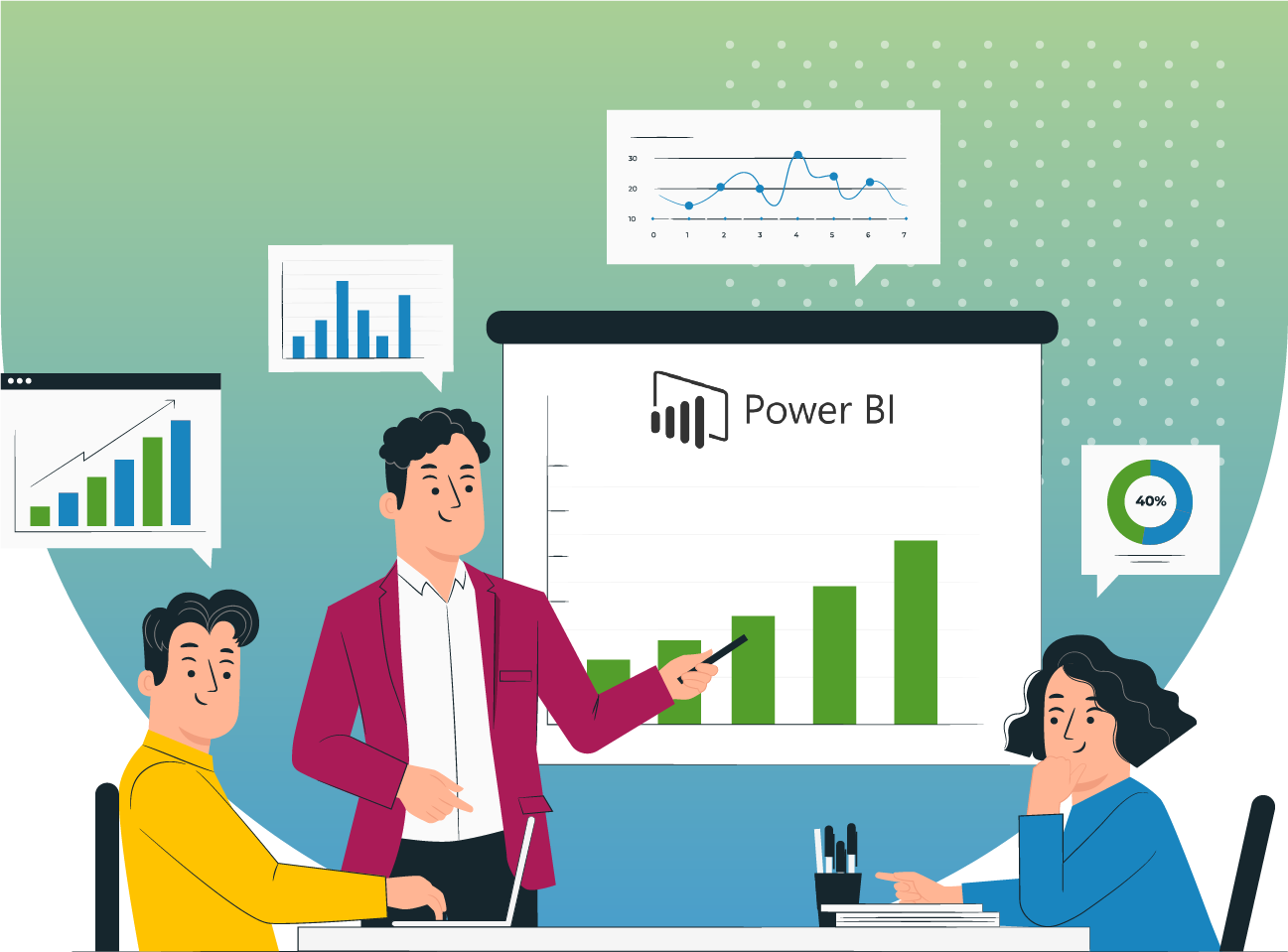Generative AI and Power BI: A Powerful Duo for Data Analysis

Strong 8k brings an ultra-HD IPTV experience to your living room and your pocket.
In today's data-driven world, businesses are under constant pressure to make fast, informed decisions based on vast amounts of data. The challenge is not just collecting data, but transforming it into meaningful insights that drive strategy. That’s where Power BI—Microsoft’s business intelligence platform—has gained traction. Combined with the rise of Generative AI, this duo is transforming how businesses analyze, interpret, and act upon their data.
Generative AI, which involves algorithms capable of creating new content or solutions based on existing data, complements Power BI’s robust data visualization and reporting capabilities. By integrating these technologies, businesses can enhance their analytical processes, automate decision-making, and optimize their data workflows for better results.
In this article, we will explore the synergy between Generative AI and Power BI, how this combination enhances data analysis, and how Power BI consulting companies and Power Apps development services can help businesses leverage this powerful duo.
What is Power BI?
Before we delve into the benefits of integrating Generative AI with Power BI, let’s briefly review what Power BI is and why it’s such a crucial tool for businesses. Power BI is a suite of business analytics tools that allows users to visualize and share insights from their data. It connects to hundreds of data sources, transforms raw data into insightful dashboards, and helps organizations make data-driven decisions.
Key features of Power BI include:
Customizable Dashboards: Allows users to create visualizations that highlight key performance metrics.
Data Integration: Easily integrates with various data sources like databases, Excel, cloud services, and third-party apps.
Interactive Reporting: Offers dynamic, interactive reports for deeper data analysis.
Collaboration: Supports sharing of reports and dashboards for team collaboration.
Given these capabilities, Power BI is already a powerful tool. However, when paired with Generative AI, businesses can unlock even more potential.
What is Generative AI?
Generative AI refers to a class of artificial intelligence models that create new content, whether it be text, images, music, or even code, based on patterns found in existing data. In the context of business analytics, Generative AI can help automate data processing, generate predictive models, and provide insights that would otherwise require significant human intervention
Unlike traditional AI that focuses on classification or prediction based on predefined data, Generative AI creates novel outputs. For example, in a business scenario, Generative AI can take historical sales data and generate new forecasts, suggest marketing strategies, or simulate the outcomes of different business scenarios.
By integrating Generative AI with Power BI, businesses can improve decision-making, automate repetitive tasks, and extract richer insights from their data.
Also Read: Why Power BI Consulting Services are Essential for Data-Driven Decision-Making
The Benefits of Integrating Generative AI with Power BI
1. Enhanced Data Insights and Predictions
One of the core functions of Power BI is data visualization and reporting. While Power BI excels in showing current trends and historical performance, integrating Generative AI takes this a step further by predicting future trends based on historical data.
Generative AI can analyze past performance data and generate predictive models that project future outcomes, such as sales forecasts, customer behavior predictions, and potential market shifts. These AI-driven insights can be seamlessly integrated into Power BI dashboards, offering users a combination of real-time reporting and future predictions in a single view.
For instance, marketers can use Generative AI within Power BI to forecast campaign performance, adjust budgets, or identify optimal strategies for customer engagement. The predictive insights provided by Generative AI help businesses stay ahead of the curve by anticipating changes in the market, customer preferences, or operational challenges.
2. Automating Data Preparation and Transformation
Data preparation is often one of the most time-consuming tasks in the data analysis process. Power BI provides data transformation tools, such as Power Query, but the integration of Generative AI can automate this step to an even greater extent.
Generative AI can help clean and preprocess data more efficiently by identifying patterns, flagging outliers, and even suggesting data transformations based on the type of analysis being performed. This means that data scientists and analysts no longer need to spend significant amounts of time on repetitive data wrangling tasks, allowing them to focus more on strategic analysis.
Additionally, Generative AI models can autonomously generate insights from raw data, suggesting ways to visualize the data and highlighting trends that might not be immediately obvious. This streamlines the workflow and accelerates the time it takes to move from raw data to actionable insights.
3. Natural Language Querying and Reporting
Generative AI enhances the interactivity and accessibility of Power BI by enabling natural language querying. With traditional BI tools, users often need to have a good understanding of the data structure and reporting tools. However, by leveraging AI, Power BI users can ask complex questions in natural language and receive instant, data-driven responses.
For example, a user might ask, "What were our top-performing products last quarter?" or "How will a 10% increase in ad spend affect our sales?" Generative AI processes these natural language inputs, understands the context, and generates accurate reports or forecasts on the fly.
This type of AI-powered functionality makes Power BI more accessible to non-technical users, enabling executives, managers, and other decision-makers to interact with the data directly without needing to learn complicated query languages.
4. Data-Driven Content Creation
Generative AI’s ability to create content is not limited to text. It can also be used to automatically generate Power BI reports, summaries, and other documents based on the latest data. This content can be customized for different audiences, such as executives, team members, or external stakeholders.
For example, after a marketing campaign, a report could be automatically generated, summarizing key metrics like conversion rates, ROI, and customer engagement, while offering insights into why the campaign succeeded or failed. This type of automated reporting saves time and ensures consistency across reports.
The Power Apps development services can further enhance this functionality by embedding these AI-generated reports directly into custom applications, making it easy to access real-time insights and actionable content wherever needed.
5. Improved Data Collaboration and Decision-Making
Collaboration is essential in today’s fast-paced business world, and combining Generative AI with Power BI enhances this capability. Power BI’s sharing and collaboration features are taken to the next level when users can leverage AI-generated insights and predictive models.
For instance, AI can suggest optimal business strategies or simulate different decision-making scenarios, which can then be reviewed collaboratively. Teams can adjust parameters or generate different models based on the input from various stakeholders. The integration of AI-powered insights into Power BI fosters a more data-driven, collaborative environment, ensuring that all team members are aligned and working with the most up-to-date, accurate information.
6. Enhanced Customization and Scalability
A Power BI consulting company can tailor Power BI’s features to meet the unique needs of a business. With Generative AI added into the mix, businesses can receive even more customization. Generative AI can analyze usage patterns, suggest tailored visualizations, and even generate personalized dashboards for each user based on their role and the data they interact with most.
This level of personalization ensures that the tool remains scalable as businesses grow. As data complexity increases, the AI-powered elements in Power BI will scale to handle larger datasets, more intricate analyses, and more advanced reporting needs.
The Role of Power BI Consulting Companies and Power Apps Development Services
Although Power BI and Generative AI offer powerful capabilities, leveraging them effectively requires specialized knowledge. Power BI consulting companies can help organizations implement these tools in ways that align with their specific business needs, ensuring they maximize the value of their data.
Consultants can help with:
Custom Data Models: Building AI-driven data models that enhance reporting and forecasting.
Integration: Seamlessly integrating Generative AI with Power BI for better data insights and predictions.
Training: Ensuring team members can use AI-powered Power BI features effectively.
Similarly, Power Apps development services can help organizations build custom applications that integrate with Power BI, making it easier to visualize AI-generated insights in the context of specific business processes. These custom apps provide real-time, actionable data in a more accessible format.
Also Read: Power BI for Marketing Analytics in 2024: Uses and Advantages
Conclusion
In 2024, combining Generative AI with Power BI creates a powerful analytics solution for businesses of all sizes. This dynamic duo enhances data analysis by providing predictive insights, automating data preparation, and enabling natural language querying. When partnered with Power BI consulting companies and Power Apps development services, businesses can fully unlock the potential of this technology, streamlining decision-making, improving collaboration, and optimizing performance across all departments.
As organizations continue to embrace digital transformation, the integration of Generative AI with Power BI will undoubtedly become a cornerstone of data analysis, helping companies stay ahead of the competition and thrive in an increasingly data-driven world.
Note: IndiBlogHub features both user-submitted and editorial content. We do not verify third-party contributions. Read our Disclaimer and Privacy Policyfor details.







